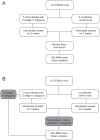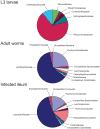Alteration of the murine gut microbiota during infection with the parasitic helminth Heligmosomoides polygyrus
- PMID: 20848461
- PMCID: PMC2959136
- DOI: 10.1002/ibd.21299
Alteration of the murine gut microbiota during infection with the parasitic helminth Heligmosomoides polygyrus
Abstract
Background: In a murine model of inflammatory bowel disease (IBD), treatment of colitis in IL-10 gene-deficient mice with the parasitic helminth Heligmosomoides polygyrus ameliorates colonic inflammation. The cellular and molecular mechanisms driving this therapeutic host response are being studied vigorously. One proposed mechanism is that H. polygyrus infection favors the outgrowth or suppression of certain bacteria, which in turn help modulate host immunity.
Methods: To quantify the effect of H. polygyrus infection on the composition of the gastrointestinal (GI) tract microbiota, we conducted two independent microbial ecology analyses of C57BL/6 mice. We obtained and analyzed 3,353 bacterial 16S rRNA encoding gene sequences from the ileum and cecum of infected and uninfected mice as well as incective H. polygyrus larvae at the outset of the second experiment and adult worms taken directly from the mouse duodenum at the end of the second experiment.
Results: We found that a significant shift in the abundance and relative distribution of bacterial species in the ileum of mice is associated with H. polygyrus infection. Members of the bacterial family Lactobacillaceae significantly increased in abundance in the ileum of infected mice reproducibly in two independent experiments despite having different microbiotas present at the outset of each experiment.
Conclusions: These data support the concept that helminth infection shifts the composition of intestinal bacteria. The clinical consequences of these shifts in intestinal flora are yet to be explored.
Figures




References
-
- Asakura H, Suzuki K, Kitahora T, et al. Is there a link between food and intestinal microbes and the occurrence of Crohn’s disease and ulcerative colitis? J Gastroenterol Hepatol. 2008;23:1794–1801. - PubMed
-
- Bernstein CN, Shanahan F. Disorders of a modern lifestyle: reconciling the epidemiology of inflammatory bowel diseases. Gut. 2008;57:1185–1191. - PubMed
-
- Goh K, Xiao SD. Inflammatory bowel disease: a survey of the epidemiology in Asia. J Dig Dis. 2009;10:1–6. - PubMed
-
- Shanahan F, Bernstein CN. The evolving epidemiology of inflammatory bowel disease. Curr Opin Gastroenterol. 2009;25:301–305. - PubMed
